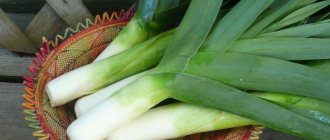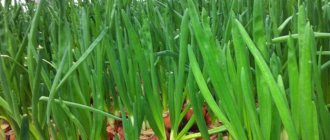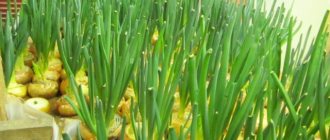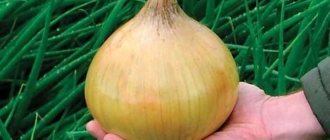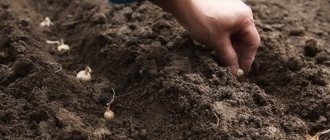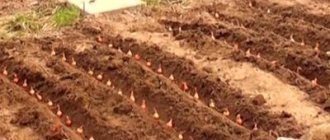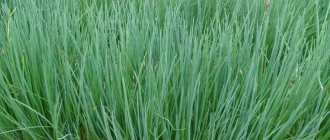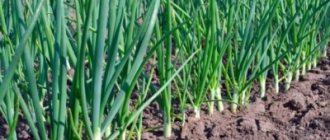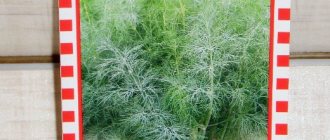Vegetable growing » Onions
0
2974
Article rating
Kira Stoletova
Growing onions has always been considered a useful and accessible activity for everyone. Not only does the vegetable contain a huge amount of useful components, but there are also no difficulties in planting onion seeds on greens at home. Often, the human body needs vitamins during the winter and spring periods, so by this time the proper supply of nutrients must be replenished. You can ensure your health by planting onions on greens in time, which, by the way, are much healthier than the onion itself.
Growing onions for greens from seeds
The best time for planting is considered to be early spring, late winter or autumn. The seeding rate is always indicated in the instructions for the selected onion. Mostly, planting occurs in 5-6 lines, leaving a distance of up to 20 cm. All seeds are pre-soaked and planted in a “swollen” state. To learn about the best way to plant onions from seeds and how to choose a suitable site for cultivation, just spend a few minutes of time on the following information.
What varieties of onions are suitable for growing onions?
You can grow not only the usual onions, but also leeks, shallots, batun, slime and others. When choosing a variety, you should pay attention to multi-germ ones: on a section of the bulb you can see not one, but several feather germs.
The best varieties of onions for this activity are the following:
- Strigunovsky;
- Arzamas local;
- Cataral;
- Yantarny-29;
- Family;
- Chernigovsky-4;
- Spassky local improved;
- Globe;
- Rostov local improved.
Each of these varieties has from 1 to 5 rudiments in one bulb, and Spassky local improved - up to 7-10. Rostov local improved is one of the earliest ripening, it is resistant to disease and cold.
As for shallots, you can choose the following varieties: Krepysh, Vulcan, Garant, Vitamin Picture, Airat, Cascade. This onion is unpretentious, but the quality of its greens is noticeably superior to that of onions.
The feathers of leeks are similar to garlic. They are very powerful and are not very suitable for growing on a window. For growing for feathers, it is best to choose the following varieties: Alligator, Bandit, Karantansky, Columbus, Vesta, Kazimir, Tango, Pobeditel.
The best varieties of batun are Seryozha, Aprilsky, Pierrot, Baron, Tenderness, Izumrudny. Among them there are both annual and perennial. The latter's feathers can be cut off up to three times per season.
Slizun is distinguished by wide, flat leaves, is an early ripening plant, tolerates cold well, and is highly productive. The best varieties: Dwarf, Green, Charm, Leader.
Growing green onions for greens is a profitable and affordable business
What are the advantages of this method of obtaining salad greens?
Everyone knows that onions are an assistant to our immunity in the fight against various bacteria and infections , because the fruits contain vitamin C (read more about the health benefits and harms of green onions here). Also, onion feathers look great on any table, so buying an onion is twice as easy and cheaper than feathers. In winter, prices rise even higher. To avoid getting into an uncomfortable situation, it is better to prepare in advance and acquire your own seedlings.
100 grams of onions contain the daily requirement of vitamin C for humans. Even a little more.
Gardeners know that growing a few bulbs in a greenhouse is profitable. The product is in high demand, so someone is even putting the process on stream. There are two ways to grow onions for greens.
- The first and very simple one is with whole onions. The fruits do not require any care or special soil. In winter, additional lighting is not needed, and almost all specimens sprout.
- When choosing to plant seeds, you should also take care of the quality of the soil. During the growing season in the first month, onions need to be illuminated if this happens in winter. You also have to be patient and persistent - the first feather will come out only after a month and a half.
Sevok can be cut after two weeks. However, the bulbs do not live longer than three months.
The life of a set is very short, but the fruits from the seeds will last you a long time. You will be able to eat fresh vegetables for about three years. If you also take care of feeding, the onions will live even longer.
You can fertilize fruits grown from seeds with vermicompost or a special concentrate. Of course, it is better to choose planting onions with seeds so that they “serve” you faithfully for many years.
When to plant
Planting time depends on the area and its climatic conditions.
When planting in open ground, you must wait until the soil warms up to 8-10 degrees.
One thing to consider when purchasing an onion is its ability to withstand low temperatures.
If you need early onions for harvest, you need to pay attention to the varieties that are planted in winter. They need to be planted in the first days of autumn frosts. In central Russia this is the end of September. It is sown in pre-prepared and fertilized beds.
For spring planting, use seedlings. The bulbs should be between 1.5 and 5 cm in diameter. Landing times in the Central region are usually the last days of April and the first days of May. The soil should warm up and maintain a stable temperature of 5 degrees. Frosts should be short. In Siberia, planting in the ground begins 1.5-2 weeks later.
In summer, onions are planted several times. Planted in August will produce greenery in mid-September, so for August plantings you need to choose early ripening varieties. It is advisable to plant them not in the ground, but in a greenhouse or container, so that when it gets cold, they can be moved to a warm place.
Perennial varieties are sown in July. The onions will sprout in March. It should be remembered that the ground with plantings is mulched for the winter to avoid freezing of the plants.
Plant care
Caring for onions is the easiest of all types of vegetables. March spring soil contains enough moisture. If you fertilize when planting and keep the soil loose, there is virtually nothing you need to do. A couple of weeks after the seedlings take root, you will need to provide:
- watering - once a week;
- loosening and removing weeds - a day after watering;
- fertilizer - 2 times: the first in the 3-leaf phase, the second in the 5-8-leaf phase.
Watering and fertilizing
The root system of the bulb is very small and located no deeper than a few centimeters. This feature must be taken into account when watering.
Find out more about how to properly water onions.
The basic rules for watering are as follows:
- You need to water immediately if the soil looks dry;
- watering should be regular (about once a week), since irregularity leads to cracking of the bulbs;
- You need to water to a depth of 3–5 cm, no more, so as not to wash nutrients deep into the soil, beyond the reach of the onion root system;
- water in the root zone so as not to provide moisture to growing weeds;
- Water the onion in the morning so that the moisture is absorbed and the bulb has less contact with water.
Do not water the beds in the evening.
This promotes the development of putrefactive microorganisms. At the end of the growing season, stop watering if you see the tops of your greens starting to turn yellow. Did you know? Libya consumes the most onions in the world. Each Libyan eats about 34 kg of onions every year.
The fertilizers needed by any plant include nitrogen, phosphorus, and potassium. They are necessary to carry out the following tasks:
- nitrogen is required for the development of roots and leaves;
- phosphorus - for rooting and bulb formation;
- potassium - for photosynthesis and enhancing cellular metabolism.
The onion is fed for the first time when 3–5 leaves are formed. During this period, it is necessary to create conditions for the formation of bulbs. The process is achieved through photosynthesis and the accumulation of nutrients from the soil. Use urea fertilizer at this stage (1 tbsp per 10 liters of water). You can also add 1 tbsp. l. potash fertilizers.
Video: Feeding onions against yellowing and pests
The second time, fertilizing will be needed for intensive formation of greenery. It is carried out in the phase of 5–8 leaves. Use potassium monophosphate (1 tbsp fertilizer per 10 liters of water). Timely application of fertilizers ensures high yields and quality characteristics of the products.
Loosening and tillage
The purpose of loosening is to loosen the soil so that the roots can “breathe”, as well as to destroy the root system of the weeds. The small root system of onions does not allow it to compete for nutrients with weeds that have more powerful roots. By removing them, you provide beneficial plants with nutrition and yourself with a harvest.
Till the soil after each watering. You need to loosen to a depth of 5 cm so as not to damage the onion roots. If it rains, you need to loosen it as soon as the soil dries out a little after the rain.
Moisture helps remove weeds more easily. Upright plants are pulled out by the roots, and creeping roots are cut with pruning shears, since it is quite difficult to completely pull them out of the ground.
To prevent the appearance of weeds, mulching is used between rows. This can be organic material (straw, sawdust) or inorganic (agrofibre, spunbond). The covering material also prevents pests from entering the soil and drying out the soil.
Did you know? According to an ancient English superstition, if the onion crop is harvested with a thick skin, then the winter will be harsh and very cold.
Preventive measures against diseases and pests
Thanks to early spring planting, onions do not suffer from pests. But considering that it is also grown for feathers in the summer, you need to take timely measures. Insect traps (sticky tape) are installed near the crops. This will help to notice pests before damage is caused to the plantation. After insects are detected, crops are treated with insecticides.
Before planting onions, the following steps are also carried out:
- autumn deep digging of the soil to destroy pests;
- compliance with crop rotation rules, since some pests can survive in the soil for several years;
- mandatory treatment of seed with fungicides to protect against bacteria and viruses;
- treating the soil with fungicides a week before planting onions in the beds;
- removal of tops and organic residues after harvesting.
How to choose seeds and onion sets
It is important to choose the right planting material.
The set should have a bulb size - from 3.5 to 5 cm in diameter, its weight - 25-45 g. It is better to plant the heads of approximately the same size - then they will sprout at the same time. Dry husks should be removed. There are no cracks or signs of rot or mold on the bulbs.
The smell of healthy onions is subtle, but by no means pungent.
When choosing seeds, you need to determine their germination capacity. To do this, they are immersed in water for 6-8 minutes. Those who float to the surface have a low chance of ascending. Another way to check: spread the seeds on a cloth soaked in water and wait for sprouts - those that do not sprout can be thrown away.
The age of onion seeds for planting should be no more than 2 years.
How to prepare
Sevok
The process of preparing for planting consists of several stages:
- Disinfection. Necessary for the prevention of diseases such as peronosporosis. The disinfecting solution is prepared from potassium permanganate. You can buy a ready-made fungicide. Such means include “Maxim Dachnik”.
- Stimulation. In order for the bulbs to begin to actively grow, they need to be stimulated. They are immersed in water heated to 35-40 degrees. Next, cover with a piece of cotton fabric or burlap and dry at a room temperature of 23 to 26 degrees. They should not be exposed to sunlight.
- Cutting off the tops. The top of the bulb must be cut off by 5-10 mm. This will ensure oxygen access to the buds, which will accelerate their growth.
Seeds
Before planting, the seeds are washed and placed in warm water for a day. It needs to be changed from time to time. After this, the seeds are immersed for 1 hour in a solution of potassium permanganate, then in a ready-made antifungal solution. Such drugs include Baikal, Epina, Heteroauxin. Disinfect the seeds at room temperature for 16 hours.
Growing conditions
In order for onion greens to grow well, you need to observe the temperature and light conditions.
Onions love light, so they need to be provided with good lighting. At the beginning of growth (first 14 days), the plant should be illuminated for 10-12 hours a day. During the active growth phase, light is needed constantly - 20-24 hours a day. In this case, the bulb will not rot and the leaves will not turn yellow.
The optimal temperature for active growth is from 23 to 25 degrees. Under such conditions, onions grow up to 30 cm in height in 14 days. Overheating is harmful to the plant. At 26-28 degrees, the feather quickly withers and loses its juiciness. At 30 degrees it stops growing.
Growing methods
At home
Growing onions at home is quite simple and profitable. Already 2-3 weeks after planting it can be harvested. There are several ways to grow onions: in soil, in water, in sawdust, in a bag, in egg cells, in plastic containers, in hydroponics.
In the ground
To grow onions in the ground, you will need a container, prepared bulbs and a substrate (as a rule, a universal one is used).
The substrate needs to be moistened. The water should be at room temperature. Place the onion in a glass upside down and leave for 1-2 days. After this, transfer it to the ground and press it lightly. It is not recommended to deepen the bulb too much, otherwise rotting may begin inside it. Until greenery appears, the temperature should be kept at 25-27 degrees. When the feathers reach 2 cm in height, it should be reduced to 22 degrees.
The container with plantings should not be placed on a radiator or placed near heating devices, otherwise the soil and feathers may dry out. Onions require a warm place, no draft, and the presence of artificial lighting.
Traditionally, onions are grown at home in universal soil.
In water
If there is no substrate for growing onions for greens, you can use a tray with water. First, the bulb is germinated to develop its roots. Next, pour water into a glass or other container, place an onion stand on it so that only the roots are in the water, and the bottom of the head should not touch the water. Water needs to be added periodically as it evaporates.
The easiest way to grow onions on a windowsill is to place their roots in a container of water.
In egg cells
This method is often used to grow onions at home for family needs due to its cheapness and convenience.
The cell is disinfected with hydrogen peroxide, the bottoms are cut out and placed in a tray with water. The roots of the bulbs sprout. To do this, place it in a glass of warm water for 1-2 days, not forgetting to change the water. Then the top is cut off, the dry husks are removed, dried and placed in a cell with the root down so that they reach the water in the pan. In this case, the bottom of the bulb should not touch the water. The water in the pan is changed at least once a week. If the water turns green, you need to put a few tablets of activated carbon into it. It is better to change it and first let it settle at room temperature. It is necessary to provide the onion with natural or artificial lighting.
To grow onions, you can use cardboard, foam or plastic cells, but the former are preferable because they are breathable and biodegradable.
In the sawdust
The advantages of sawdust are breathability, moisture, and warmth. As a result, the green mass grows very quickly. In addition, no fertilizer is required. Pressed or loose sawdust is suitable.
First, you need to pour boiling water over them, pour in a little manganese solution to disinfect and reduce acidity. They should swell and increase in volume.
When growing onions in sawdust, it is possible to get a fairly large harvest in just a few weeks.
The bulbs are placed tightly on sawdust, after removing the dry husks from them. It is not recommended to recess the heads. Every 3-4 days it is necessary to water. After harvesting, the sawdust should be thrown away. They are not reused.
Advice! To grow onions, it is recommended to use sawdust from deciduous trees only. Conifers, due to their high resin content, spoil the taste. It is advisable to give preference to fruit wood, such as apple.
In the package
Another way to grow onions is in a plastic bag. Moistened paper napkins, sawdust or cotton wool are placed on its bottom. Onions with the tops cut off are placed on the moistened material. The bag must be buried to prevent air from entering inside. When the greens hatch and the feathers grow to 6 cm, you need to open the bag and slightly moisten the roots. In about 10-14 days, the greens will grow to the desired size.
The easiest way to get green onions is to sprout them in a plastic bag
In plastic containers
It is necessary to prepare clean plastic bottles with a volume of 3-5 liters. You need to cut holes in them around the circumference of the container or in a checkerboard pattern, which should be smaller than the size of the bulbs. The diameter of the bulbs used is 4-6 cm, it is better not to take smaller ones.
Cover the bottles with soil, which can be brought from the garden plot or bought at the store. Usually a universal substrate is used. Insert the onions with the tops cut off into the holes made. The roots must be inside the container. It is recommended to water 1-2 times a week, and also spray with a spray bottle. Plastic containers are placed on a pallet.
An original and practical option is to plant onions on greens in plastic bottles
On hydroponics
This method allows you to grow onions even in a city apartment. Important advantages are no dirt and compactness: containers can be installed in several tiers. Using this technology, onions are grown without the use of soil (in artificial media). This method is very popular because it saves space and produces large yields during the cold season. It is usually used when growing greens for sale. To do this, you need a special hydroponic installation, which you can buy or make yourself.
Is it possible to grow ginger at home?
You should know that not every onion variety is suitable for growing hydroponically.
Experts recommend the following:
- Seryozha;
- Union;
- Ural family;
- Bessonovsky;
- Strigunovsky;
- Seven-year-old.
Bulbs from the fall harvest are best. Specimens of approximately the same size are selected - 2-3 cm in diameter. Planting material must be prepared before planting. The bulbs are bubbled to stimulate growth. This process consists of placing the material in a bucket of water with wood ash heated to 38 degrees, placing an aquarium compressor in it, turning it on and leaving it for 12 hours. Then you need to cut off the tops as much as possible, clean the bottoms, without in any way damaging the pulp. Thanks to these manipulations, roots and greenery appear faster.
To grow, you will need an airtight container with a hard bottom and a tight-fitting lid. Its approximate size: length - 80 cm, width - 40 cm, height of sides - 20 cm. This container must be wrapped in light-proof material so that the roots are in complete darkness. The lid should have holes for the bulbs (for the indicated sizes there will be 50-60 of them).
Prepared bulbs are planted on mats or slabs of mineral wool, abundantly soaked in a solution of fertilizers, which are sold in specialized stores. Such substrates are suitable for reusable use. The artificial substrate must always remain moist. The distance between the bulbs is 2 cm, between the rows - 4 cm.
Interesting! Growing hydroponically allows you to collect 10 kg of greenery from 1 square meter. meters. For 1 sq. You can plant approximately 10-12 kg of bulbs per meter; 1 kg yields approximately 800-900 g of greenery.
In the greenhouse
You can plant onions on greens in a greenhouse using seeds and bulbs.
In greenhouse conditions, onions grow much faster than in open ground. The disadvantage of this method is that the greenhouse requires quite expensive maintenance. It needs to be equipped with lighting, heating, shelving with drawers, and an irrigation system. In addition, it is necessary to provide access to fresh air.
Using a greenhouse is a good idea for growing onions for sale.
It is more efficient to grow feathers from sets. Small bulbs yield a harvest in 95% of cases; there are no special problems when growing.
Growing onions for greens from seeds is more troublesome. To plant them, first make furrows with a distance of 15 cm between them. It is not recommended to deepen the seeds. Sowing should be frequent so that the bulbs are small and there is more greenery. When sowing in spring, you need to take 25% less seeds than when sowing before winter. If the greenhouse is heated, the daytime temperature in it should be maintained at 18-20 degrees, and at night it should be lowered to 15 degrees. When the feather appears, it needs to be increased to 22 degrees. Lighting should be present for 12-14 hours. If the greenhouse is not heated, after sowing before winter it is necessary to mulch with humus or peat. The layer of peat chips is at least 5 cm. At the end of winter, the covering layer must be removed, water the onions and stretch the film until the sprouts appear.
In the open ground
Planting in open ground is carried out in spring and autumn. The soil must be prepared in advance; if not prepared, the harvest will be significantly lower. In spring, planting begins with the onset of warmth, in autumn - before frost.
It is important to choose the right place. The area should be well lit. It is advisable that tomatoes, zucchini, pumpkin, and potatoes grow on it before this. The soil should not be acidified. There should be no weeds in the soil. The soil needs to be moistened within a few days.
Furrows are prepared for planting seedlings. The distance between the bulbs is 6 cm, between the beds - 16 cm. If planting occurs in the fall, mulching is required (layer thickness - about 7 cm). In the spring, a film greenhouse is built in case of frost.
If you follow the rules of agricultural technology, good yields of high-quality green onions can be obtained in open ground
Useful tips
There are many tricks and tricks in growing onions, thanks to which you can get a lot of greenery and get rid of possible problems. Important Recommendations:
- Egg trays can replace expensive hydroponics. To do this, take 1 plastic tray, dividing it in half. The lid will act as a pallet, the cell as the upper tier. Cut off the bottom of each cell and place the bulbs in the holes. Pour water into the tray, place the top tier, placing wooden sticks between the two elements. This is necessary so that only the roots and not the bulbs are in the water.
- Whatever you grow the bulbous feathers in, be sure to place trays under the containers and containers to drain water after watering.
- Onions love light - without it, the feathers become light, yellow and limp. Therefore, in winter, it is necessary to provide the “beds” with additional light - install a phytolamp, a fluorescent installation, and the like.
- If the apartment is too hot, the onion stops the growth of green mass. In these cases, you need to wrap the container with regular foil, which will protect the heads from overheating.
- Soil taken from the street may contain insects and pest larvae, which, under favorable conditions, actively reproduce. To prevent this, do not refuse the disinfection procedure with boiling water. The earth can be fried in the oven for 10-15 minutes.
- For forcing greens, try to select mother bulbs that produce 2-3 times more feathers.
By growing bulbs for feathers, regardless of the method, you can delight your family with fresh herbs all year round. The main thing is to decide on the planting method, strictly follow the requirements of agricultural technology and do not forget to harvest.
0
0
Copy link

